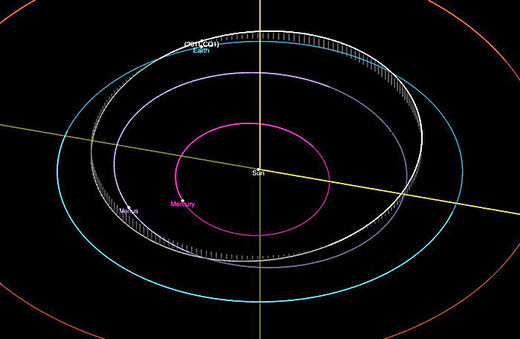
© buradaki/Stock
The dashboard supplies vital information for each encounter, including the closest approach date, approximate object diameter, relative size, and distance from Earth.
The dashboard focuses on the next five Earth approaches, all within 4.6 million miles (7.5 million kilometers or 19.5 times the distance to the moon).
"An object larger than about 150 meters that can approach the Earth to within this distance is termed a potentially hazardous object," the NASA dashboard
mentions.Asteroids making a close approachOn Tuesday, January 23, two asteroids are set for close approaches.
The first, named 2024 BA1, approximately the size of a house, will come closest to Earth at a distance of 3,270,000 kilometers.
Simultaneously,
another asteroid, 2021 BL3, measuring the size of an airplane, will pass by from a distance of 6,600,000 kilometers.
The NASA dashboard also lists three more asteroids expected to make close Earth approaches later in January.
On Wednesday, January 24, a plane-sized asteroid, 2024 AL6, will pass from a distance of 2,090,000 kilometers.
Following this, on Thursday, January 25, a bus-sized asteroid, 2017 BG92, will make a close approach at 4,500,000 kilometers.
Lastly, on Friday, January 26, a car-sized asteroid, 2011 CQ1, is expected to fly by from a distance of 4,330,000 kilometers.
None of the currently listed asteroids are on a collision course with Earth.
NASA's ongoing monitoring and public awareness initiatives, such as the Asteroid Watch dashboard, play a crucial role in tracking and providing information about near-Earth objects.

Orbit of near-Earth asteroid 2011 CQ1
On January 21, a small asteroid was observed streaking through the sky, with
NASA detecting it three hours before it collided with Earth. Notably, this marked the eighth instance in which researchers identified a space rock before its impact.Dubbed 2024 BXI, the asteroid ultimately entered Earth's atmosphere
near Berlin, generating a luminous yet benign fireball visible over a wide area.
Astronomer Krisztián Sárneczky, based at the Piszkéstető Mountain Station, which is affiliated with the Konkoly Observatory in Hungary, was the first to observe the asteroid.
Reportedly, Sárneczky used the 60-cm Schmidt telescope at the observatory to make the discovery. Following the identification of the cosmic rock, NASA provided a detailed prediction of its impact location and time.
The ability to spot and track such asteroids in advance is a significant step toward enhancing our understanding and preparedness for potential cosmic events.


Reader Comments
to our Newsletter